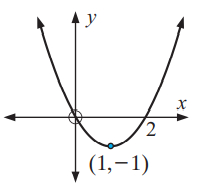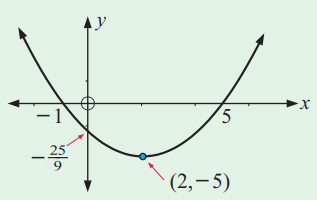DETERMINE WHETHER A FUNCTION HAS AN INVERSE
Subscribe to our ▶️ YouTube channel 🔴 for the latest videos, updates, and tips.
If the function y = f(x) is one to one, it will have an inverse function y = f-1(x).
If a function y = f(x) is many to one, it will not have an inverse function.
When we have graph of the function, it is easy to use horizontal line test to check whether it is one to one function or not.
The horizontal line test for the function says that :
for a function to have an inverse, no horizontal line can cut it more than once.
Which of the following functions have inverses ? If each of these cases, write down the inverse function.
Problem 1 :
{ (1, 2) (2, 4) (3, 5) }
Solution :
Every element is associated with different different outputs. So, it is a one to one function. It has inverse.
Inverse function :
{ (2, 1) (4, 2) (5, 3) }
Problem 2 :
{ (-1, 3) (0, 2) (1, 3) }
Solution :
The given relation is a function, but it is not one to one.
Because two different inputs -1 and 1 is having the output 3. So, it is not one to one, then inverse function does not exists.
Problem 3 :
{ (2, 1) (-1, 0) (0, 2) (1, 3) }
Solution :
Converting into arrow diagram,

it is clear that the given relation is one to one. So, it has inverse.
Inverse function :
{ (1, 2) (0, -1) (2, 0) (3, 1 ) }
Problem 4 :
{ (-1, -1) (0, 0) (1, 1) }
Solution :
Converting into arrow diagram,

it is clear that the given relation is one to one. So, it has inverse.
Inverse function :
{ (-1, -1) (0, 0) (1, 1) }
Which of the following function has inverse function.
Problem 5 :

Solution :
When we draw the horizontal line, it will intersect the graph at one point. So, it is one to one function and it has inverse.
Problem 6 :

Solution :
When we draw the horizontal line, it doesn't intersect the graph at one point. So, it is not one to one function and it doesn't have inverse.
Problem 7 :

Solution :
When we draw the horizontal line, it doesn't intersect the graph at one point. So, it is not one to one function and it doesn't have inverse.
For each of the following graphs determine :
i) range and domain
ii) find x and y intercepts
iii) Whether it is a function
iv) if it has a inverse function
Problem 8 :

i) Domain : (-∞,∞) and Range [-2, ∞)
ii) x-intercepts are -1 and 5, y-intercept is -25/9
iii) The vertical line will intersect the curve at most one point. So, it is a fucntion.
iv) The horizontal line will intersect the graph at two points(More than one point). Not one to one. Doesn't have inverse function.
Problem 9 :

i) Domain : (-∞,∞) and Range [-3, 1)
ii) There is no x and y-intercepts.
iii) The vertical line will intersect the curve at most one point. So, it is a function.
iv) The horizontal line will intersect the graph at two points(More than one point). Not one to one. Doesn't have inverse function.
Subscribe to our ▶️ YouTube channel 🔴 for the latest videos, updates, and tips.
Recent Articles
-
Finding Range of Values Inequality Problems
May 21, 24 08:51 PM
Finding Range of Values Inequality Problems -
Solving Two Step Inequality Word Problems
May 21, 24 08:51 AM
Solving Two Step Inequality Word Problems -
Exponential Function Context and Data Modeling
May 20, 24 10:45 PM
Exponential Function Context and Data Modeling